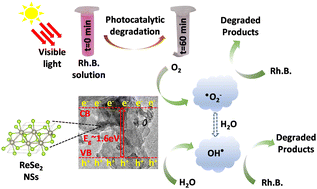Two-dimensional ReSe2 nanosheets as a high-performance photocatalyst†
Abstract
Amidst the progress made by the world economy, the textile industry is a huge contributor to economic development. However, the unplanned intrusion of discharge from the industrial effluents that contain toxic chemicals and dyes into bodies of water affects all forms of life in the environment. Thus, water pollution affects the economy in many adverse ways. The primary method for the mitigation of environmental contaminants is semiconductor photocatalysis, which is activated using solar light irradiance. In this article, two-dimensional (2D) rhenium diselenide (ReSe2) transition metal dichalcogenide (TMD) nanosheets (NSs) are synthesized using a simple and environmentally benign low-energy-intensity one-step hydrothermal approach. The synthesized optimized ReSe2 catalyst effectively degrades the organic pollutant rhodamine B (RhB) when exposed to visible-light illumination. It is found that the ratio of the ReSe2 catalyst to the RhB dye plays a decisive role in dictating the efficiency of the as-synthesized ReSe2 catalyst. The findings suggest that the optimized catalyst ReSe2 NSs show enhanced absorptivity of the dye, an extended photoresponse towards the visible domain, and enhanced charge separation and the simultaneous diffusion of the photogenerated electron/hole charge carriers to the catalyst surface. The best photocatalytic activity observed for a 4 mg/5 ml catalyst-to-dye loading ratio, resulting in a photocatalytic degradation efficiency of 87.3% for the RhB dye under visible-light illumination, which has rarely been reported for other 2D TMDs. Moreover, the optimized catalyst retains its stability during each of four consecutive cycles of dye degradation. The mechanism of photocatalysis was examined through a reactive trapping experiment. The results show that superoxide radicals and holes are the main reactive species in the photocatalytic reaction. This study was supported by the characterization tools of Raman spectroscopy, UV-Vis absorbance, XRD, TEM, SEM and XPS. Overall, with the goal of balancing aquatic ecosystems, this planned effort offers a potential remedy for the breakdown of organic contaminants under visible-light illumination.



 Please wait while we load your content...
Please wait while we load your content...